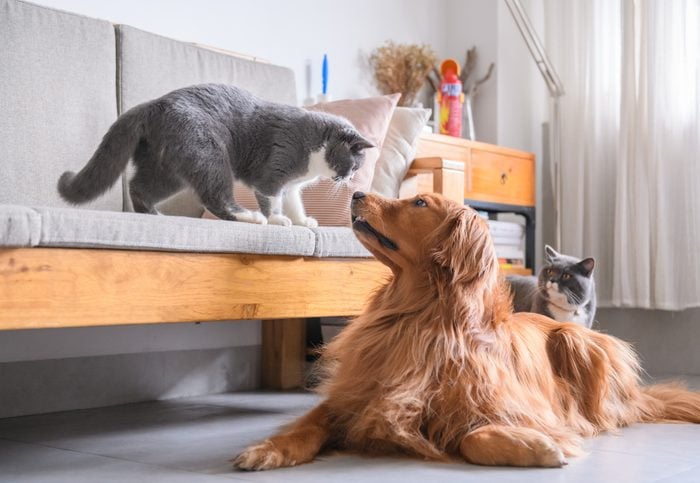
No sibling rivalry here!
We’re all familiar with the images of cats and dogs who don’t hit it off. The cat has an arched back and is hissing at the dog, while the dog looks bewildered and doesn’t understand why the cat is having a hissy fit. But you’re likely to witness something entirely different from these cats breeds—in part because they act like dogs. They love to be around their humans, are eager to play games like fetch, and some even love the water! Of course, forging a good relationship between your pets starts with a slow introduction process, but overall, these are the cat breeds that usually get along with dogs. Need more proof? Take a look at these sweet photos that show cats and dogs can be best friends.
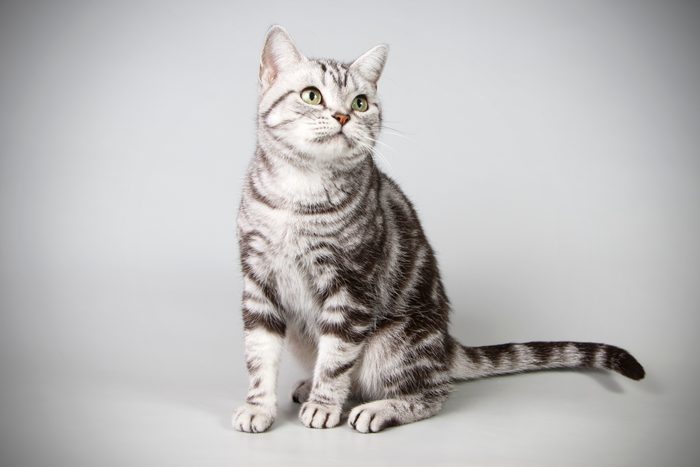
American Shorthair
Easygoing and affectionate, the American Shorthair is known for its brotherly (or sisterly) love for dogs. “This breed is considered very social, confident, and playful, and once boundaries are established in the house, they love to play with housemates, including the family dog,” says Natalie Marks, DVM, a cat expert and veterinary partner with Royal Canin. And the American Shorthair may just outlive your dog, as it can live for 15 years or longer.
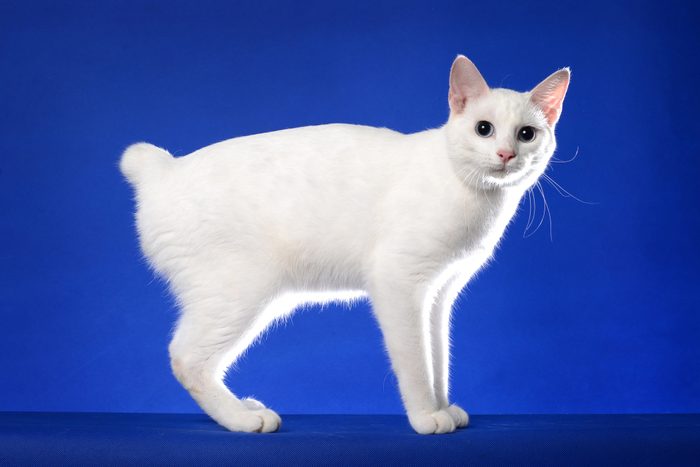
Japanese Bobtail
There’s no mistaking a Japanese Bobtail, with its trademark pom-pom tail. These cats consider themselves part of the family and want to join in on all the activities—whether that’s curling up next to you and your pup on the sofa, helping you send emails, or greeting company at the door. “You might see the Japanese Bobtail right in the mix, retrieving toys next to his canine housemate in the home,” Dr. Marks says. “Or he might be next to the water bowl, playing and splashing. This fun-loving breed is a great sibling to your resident dog.” Check out the cat breeds with the friendliest personalities.
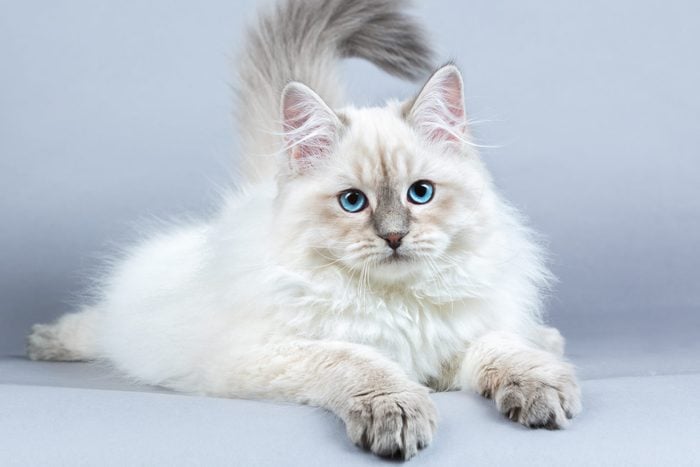
Siberian
“This cat breed hailing from Russia is very hearty and incredibly confident around other cats and dogs in the home and, in fact, may end up being the leader of all pets!” Dr. Marks says. Maybe it’s their size—up to 17 pounds—or their luxurious waves of floof that give them their confidence. As the “mayor” of the feline world, the Siberian is a friend to everyone. Siberians are rare outside of Europe, so this may be the first time you’re hearing about them. Check out these other 12 rare cat breeds you probably didn’t know about.
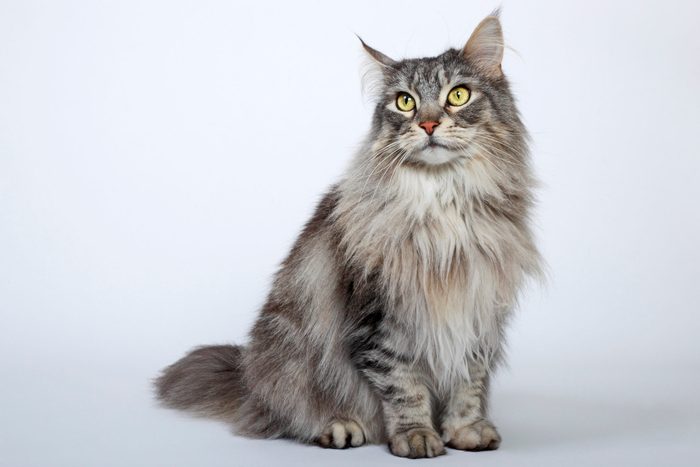
Maine Coon
Throw a ball for a game of fetch and your dog and Maine Coon might compete to see who gets to it first. This cat is native to America, specifically Maine, and has the esteemed honor of being the official cat of the state. Maine Coons are sturdy and built for activity, but they’re also easygoing and get along well with other furry members of the family. “Some pet parents find incredible similarities between the Maine Coon and a canine, as this breed typically loves to fetch and walk on a leash,” notes Dr. Marks. Maine Coons are fond of the water, but most cats aren’t. Here’s why cats usually avoid water at all costs.
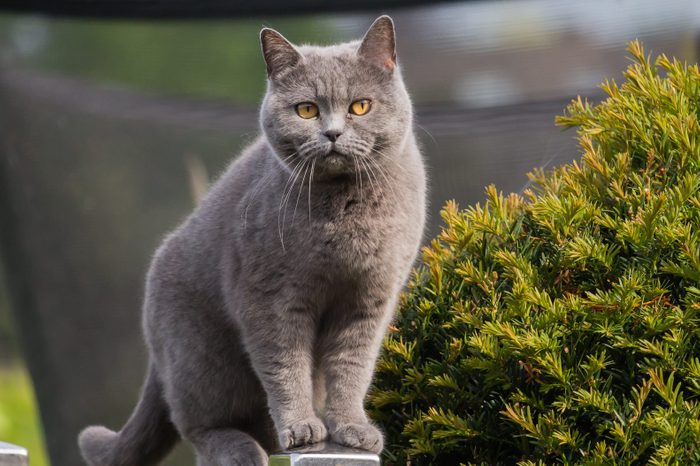
British Shorthair
It’s not just British Shorthairs’ laid-back demeanor that’s suited for being a dog’s buddy—it’s also their physique. “Their heavy, muscular body means that they’d be up for a bit of physical play with your dog,” says Teresa Keiger, a judge with the Cat Fanciers’ Association (CFA) who has lived with and shown several cat breeds. “Nothing much bothers them.” Except being picked up, that is. And it’s no wonder: They were originally known for their physical strength and hunting ability, so it would be beneath them to be picked up! No matter what kind of cat you have, make sure to avoid these potentially dangerous mistakes cat owners often make.
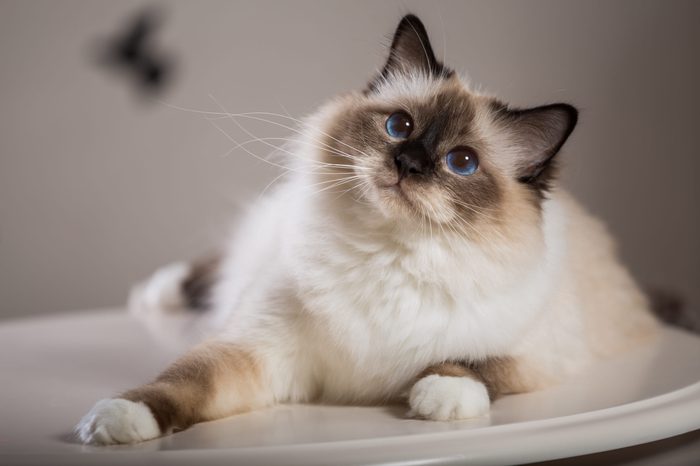
Birman
If you’re worried about your pup being lonely while you’re at work, you might want to add a Birman to the family. Given their posh appearance and luxurious fur, you might not think they’d be the perfect playmate for your pooch, but Birmans love dogs. “The traditional ‘cat and mouse’ game becomes a ‘cat and dog’ game with this breed in your house,” Dr. Marks explains. “Birmans love to chase, play tag, and even fetch balls, becoming the best playmate for your dog.” Find out other ways to keep your pet occupied while you’re at work, too.
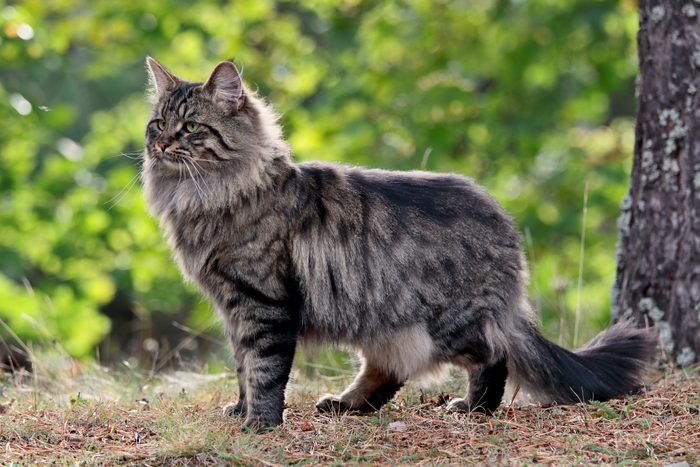
Norwegian Forest Cat
The Norwegian Forest Cat is a relatively new breed in the United States. It hails from Norway, where it’s made its home for thousands of years. You might confuse it for a Maine Coon, as they are similar in size and appearance. The Norwegian, however, has almond eyes and a straight profile. Their personalities are similar, too—both of these breeds are relaxed, friendly, and adaptable. Yet Dr. Marks says Norwegians adapt even better with a dog if they grow up together, so adopting a dog at the same time would be ideal. Don’t miss these photos of the cutest cat breeds as kittens.
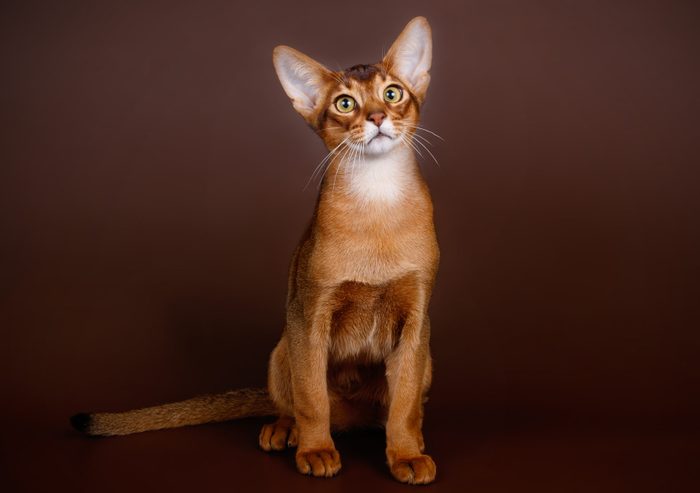
Abyssinian
“Abyssinians are a curious breed, and [they] want to interact with everything and everyone. A dog would be no exception,” says Keiger. They’re not lap cats, so your dog won’t have to compete for that coveted spot. Still, that doesn’t mean they’re not into humans—quite the opposite, in fact. Abyssinians are very people-oriented and want to be near you and know what you’re doing so they can “help.” They are always on the move and would be the perfect companion for a dog that thrives on mental and physical challenges. The only downtime Abyssinians seem to have is when they are eating or sleeping. By the way, this is why cats sleep so much.
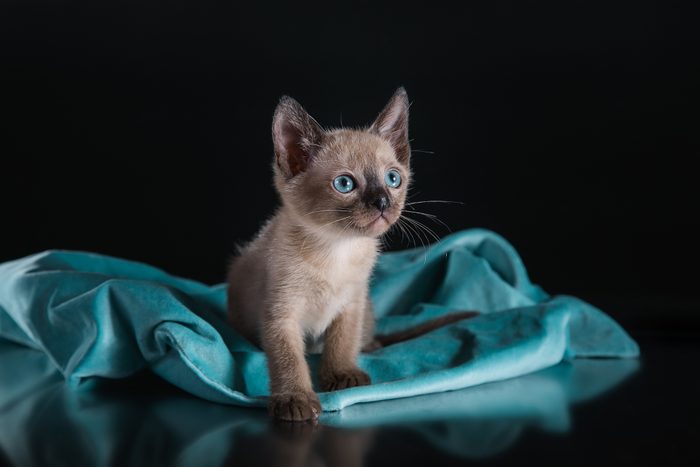
Tonkinese
The Tonkinese gets its striking looks from its Burmese and Siamese gene pool. Like the Siamese, the Tonkinese is quite vocal and may even chime in on some barking sessions with your pooch! “It may be the only cat breed to rival the fetching skills of a Golden Retriever,” Dr. Marks says. “This cat breed is super social and active, and it loves being around people and dogs. It detests being alone or ignored, so a dog would definitely be a good companion for when you’re not home.” Learn more about why cats meow.
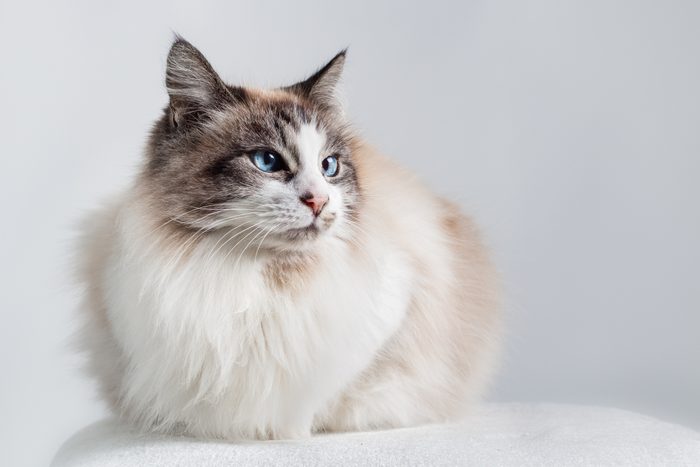
Ragdoll
Ragdolls act a lot like dogs. They’re excited to greet you at the door and welcome you home, then follow you around until they get some lovin’. They’ll even camp out on your bed and snuggle with you all night long. Their interest in other species isn’t limited to humans; they love dogs, too. “The Ragdoll can learn to walk on a leash and could even go for joint walks with your dog,” Dr. Marks says. Find out what a vet has to say about whether you should be letting your cat sleep in your bed.
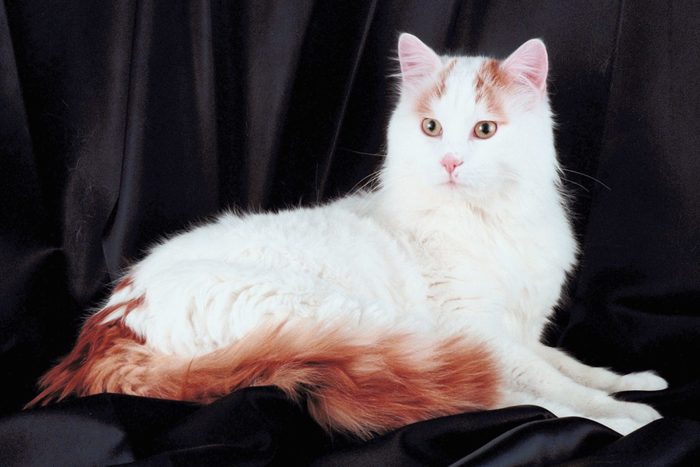
Turkish Van
If you have a dog that would rather live in the water than on the land, the Turkish Van could be your pup’s water buddy. These felines sport water-resistant, cashmere-like coats that make swimming a breeze, and they’ve been dubbed “the Swimming Cats” in their native regions of central and southwest Asia. “They love to be around and play in the water, and they can live harmoniously with dogs in the home, even playing games of fetch and retrieval, too,” Dr. Marks adds. Whether your pet loves or hates the water, this is how to bathe a cat without getting scratched.
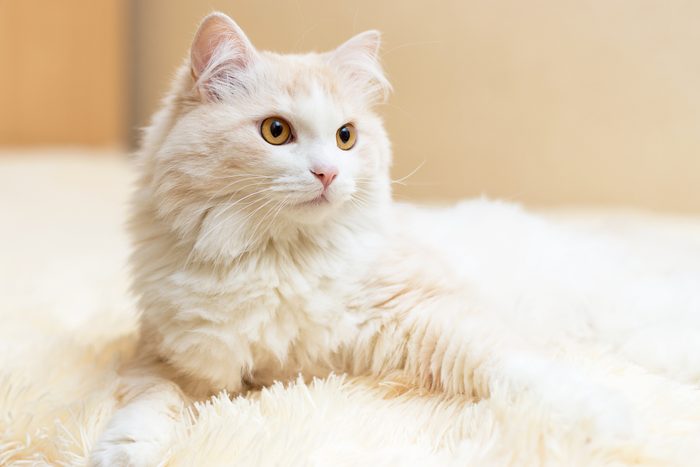
Turkish Angora
“The trickster of the cat world, this breed is hilariously funny and even loves playing pranks on resident canine siblings,” Dr. Marks says. Highly sociable and affectionate, Turkish Angoras happily welcome other furry roommates, including dogs. Fair warning, though: Your dog may not be the pack leader when a Turkish Angora is in the house. These cats tend to have an assertive nature and a commanding presence that makes them the “alpha” pet in the household. Wish you could decode your cat’s behavior? These are the 17 things your cat would love to tell you.
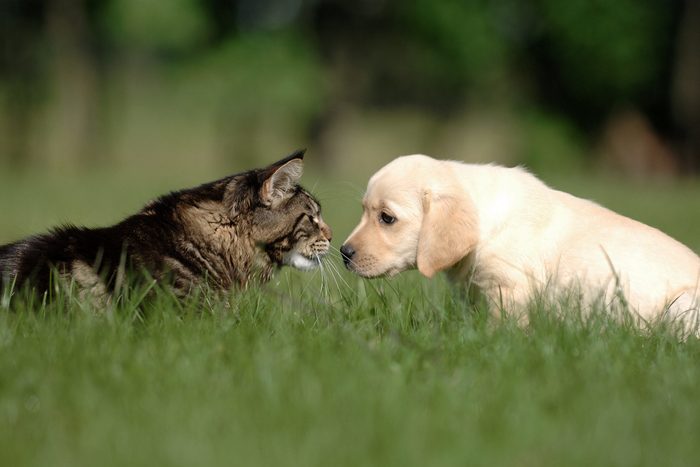
Paws-off introductions
To help build a friendly and long-lasting relationship between your fur babies, Dr. Marks recommends a slow introduction. “To start, it’s best to confine the new cat or dog to a separate room with everything he or she will need, like food, water, bedding, and a litter box for a cat,” she advises. “Feed both the cat and dog on either side of the door. This will help each pet smell the other and feel a positive feeling of reward (food) at the same time.”
In a few days, install a baby gate or crack open the door slightly (and secure it in place). This will let the animals get a glimpse of each other while they eat—but not touch. During this introductory period, also be sure to give each of them things like blankets and toys that have scents of the other animal on them. Finally, allow your cat to explore the dog’s territory while the dog is outside. “This swap of living space continues to allow your cat and dog to explore each other’s scents, and your cat will have the ability to start exploring the new space without any threats,” Dr. Marks explains. Next, check out these dogs that are good with cats for the ultimate pair